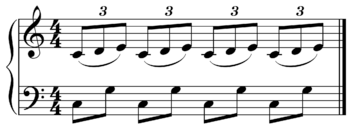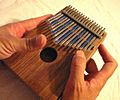Polyrhythm facts for kids

Polyrhythm is a cool musical trick! It happens when two or more different rhythms are played at the same time in music. Imagine one person tapping a steady beat, and another person tapping a different, faster beat over it. That's polyrhythm!
This musical idea is very common in many types of music. You can often hear polyrhythms in African, Latin, and Afro-Cuban music. It makes the music sound rich and exciting.
Contents
What is Polyrhythm?
Polyrhythm is like building layers of sound. One musician might start playing a rhythm. Then, other musicians join in, adding their own different rhythms on top. This creates a complex and interesting sound. It adds a lot of energy and "feel" to the music.
Polyrhythm in Action
Think about a drum circle. One drummer might play a slow, steady beat. Another drummer might play a faster, more complicated pattern at the same time. A third drummer could add a completely different rhythm. When all these rhythms play together, they create a polyrhythm.
This layering of rhythms is often used in traditional African music. It's a big part of festivals and special events. Sometimes, it's combined with a "call and response" style. This is where one musician plays a phrase, and then others answer it.
Why is Polyrhythm Used?
Polyrhythm makes music feel alive and dynamic. It can create a feeling of movement and excitement. It also adds depth, making the music more interesting to listen to. When different rhythms fit together, it can sound very powerful.
It's not just about drums! Polyrhythm can happen with any instruments. You might hear it in a piano piece, where the left hand plays one rhythm and the right hand plays another. Or in a band, where the bass, drums, and guitar each play different rhythmic patterns that interlock.
Polyrhythm Around the World
Polyrhythm is a key part of many musical traditions.
- In West Africa, it's fundamental to drumming and dance.
- In Jazz, musicians often improvise with polyrhythms.
- Classical composers, like Igor Stravinsky, have also used polyrhythm to create unique sounds.
It's a way to make music feel more complex and engaging. It challenges both the musicians and the listeners in a fun way.
Images for kids
-
Hugh Tracey Treble Kalimba






